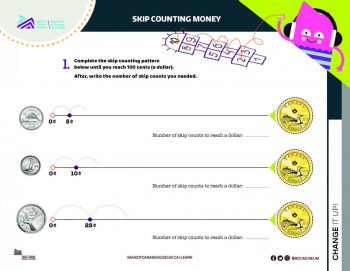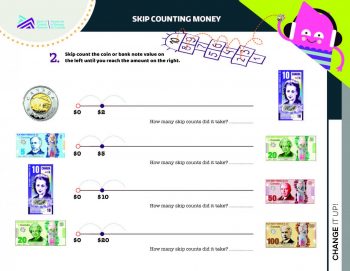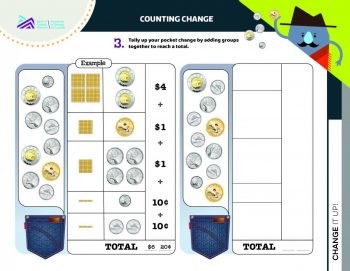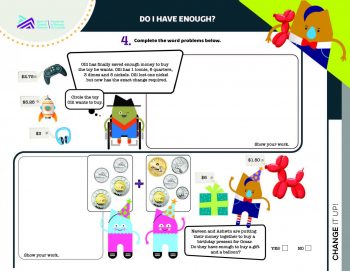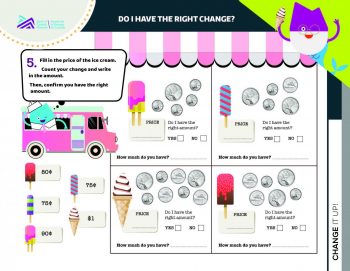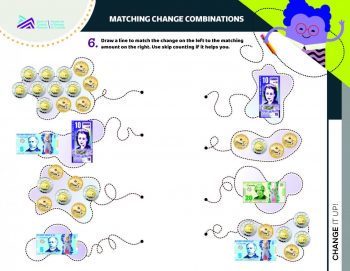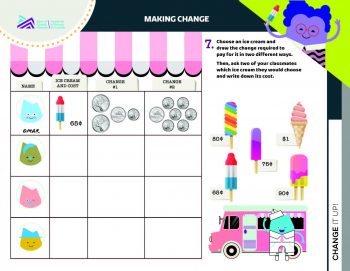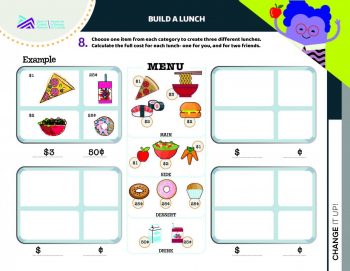
Introduce your Grade 2 students to counting money and forming change combinations. Use these four sets of money math activities individually or in the order listed in this lesson.
Overview
Big idea
Different combinations of coins and bank notes can represent the same amount of money.
Total time
90 minutes of instruction and math exercise work
Grade levels
Grades 2
Subject area
Math
- skip counting denominations of cents and dollars
- identify ways to represent the same amount of money
- adding together smaller-denomination coins to equal larger sums (combinations of coins can add up to $1, or larger sums with loonies and toonies)
- modelling different costs and change required
Learning objectives
Students will:
- use different strategies to determine the value of a combination of coins or bank notes
- represent the same amount of money in different combinations of coins and bank notes
- assess amounts of money needed for transactions using word and number problems
- identify different denominations of Canadian coins and bank notes
Materials
Classroom supplies
- pencils
- printer
- white board and markers (or smartboard or projector)
- play or real money: Canadian coins and bank notes of every denomination (optional)
- base 10 blocks (optional)
Worksheets
- Download the activity and answer sheet.
- Print one copy of the applicable worksheets for each student:
- Activity 1: Skip counting money 1 and Skip counting money 2
- Activity 2: Counting change
- Activity 3: Do I have enough? and Do I have the right change?
- Activity 4: Matching change combinations, Making change and Build a lunch
Activity 1: Using skip counting
In this activity, students will see the connection between skip counting and money counting. They will identify amounts of coins that can make up larger amounts through skip counting.
Time
20 minutes
1.1 Opening discussion
Ask your students the following questions:
- What is the difference between dollars and cents? (Cents are parts of a dollar; 100 cents make up a dollar. In Canada, while most coins are cents, some are dollar amounts, and all bank notes are dollar amounts.)
- What symbols and numbers do we use to write money amounts? (E.g., $1.25, 25¢)
- If you counted by one-dollar increments would you be counting coins or bank notes? (coins) What is the nickname for these coins? (loonies) What about two dollars? (toonies) What are the names of the different Canadian coins that represent cents? (nickel, dime, quarter)
- What is the largest denomination (or face value) of a Canadian bank note? ($100) What is the face value of the smallest Canadian bank note? ($5) What are other Canadian bank note values? ($10, $20, $50)
- Do you remember the colours of each of the bank notes and what pictures and symbols are on them?
Have your students practise skip counting using a number line. Try skip counting together, such as by twos, fives and tens.
To help with visualization, you may want your students to identify all the denominations of bank notes and coins on a number line. You could use one number line for cents, and another for dollars to help show the difference in values.
1.2 Worksheet activity: Skip counting money
Hand out one copy of the worksheets "Skip counting money 1" and "Skip counting money 2" to each student. Students will skip count coin denominations to a whole dollar amount to discover how many of each coin is needed to equal a dollar. They will do the same with whole dollar amounts (such as how many toonies equal a ten-dollar bill).
Do the first question together, and then have your students work individually or in groups. Correct the remaining questions. If necessary, use a whiteboard to go over more examples for practice.
Activity 2: Counting money
In this activity, students will practise counting change and match two different combinations of an equivalent amount of money.
Time
25 minutes
2.1 Hands-on activity
Start with a review of different strategies your students can use for counting and visualizing dollars and cents.
- Use base 10 blocks to help show the relationship between cents (single units and 10-count rods) and whole dollar amounts (100-count flats).
- Provide an example of some change to count, either with the class gathered around you or by drawing various coins on the whiteboard.
- Ask the students what strategies can help them count money (e.g., sorting coins and bank notes into groups of the same denomination).
Demonstrate to your students how to sort by denomination.
- Show that you can sort the coins into different groups according to their face value. Then count or determine the number of coins in each group.
- Use skip counting to add up the total value of each cent group (nickels, dimes, quarters) and then of each dollar group (loonies and toonies). Next, add these values together.
- Use the whiteboard or a piece of paper to tally the amounts of each group and the total value.
To help students add:
- Have them estimate the number of each cent coin required to make up a dollar. Use a number line or skip counting technique if that is helpful (or recall the activity above).
- Have students memorize how many of each coin can make up a dollar (4 quarters, 10 dimes, 20 nickels).
- Show them how to stack sets of cent coins of the same value to make up a dollar.
2.2 Worksheet activity: Counting change
Hand out one copy of the worksheet “Counting change” to each student. Go over the first pocket change example, which shows the same money-adding strategies reviewed above. Then have students complete the change-counting question on their own or in small groups. Review and correct.
Continue to the next question, where students will match different combinations of change that equal the same amount of money. Do one example together if needed, reminding students of the strategies they developed before.
If time allows:
- Give pairs or small groups of students small amounts of play money to sort and count, or draw some change on a flashcard if you don’t have any play money to use.
- Have each group write down their answer before switching change with another group.
- Have each group count their new amount of change. Repeat in successive rounds as time allows.
- At the end of the rounds, bring the class back together and confirm that each group got the same answers.
- As an alternative, make this into a game where every group has the same amount of change and competes to be the first group to count and call out or hold up the correct answer.
Activity 3: Confirming amounts of change
In this activity, students will confirm how much money they need to purchase items and represent the same amount of money using different coin combinations.
Time
15 minutes
3.1 Worksheet activity: Do I have enough?
Hand out the word problem worksheet “Do I have enough?” and “Do I have the right change?”
- Explain that both word problems will ask if the characters can afford to buy something.
- As you read out the first word problem, ask for a volunteer to draw all of Olli’s coins on the whiteboard, or have students write the values of all the coins on the worksheets. Do the addition together and see what they think the character can afford.
- Move on to the second word problem and solve it in a similar way. Alternatively, start by asking your students to use their estimation skills to guess if the two characters have enough to buy both a gift and balloon. If they have done the counting change activity above, this will be easier for them.
Next, have students apply the steps they practised in the word problems to the next worksheet with the ice cream truck Do I have the right change? Do the first problem together and show students where to place dollar and cent symbols, if helpful. Correct the answers together.
Activity 4: Collaborating to make change combinations
In these activities, students will model and confirm different amounts of money. They will also survey others to create different change combinations.
Time
30 minutes
4.1 Discussion
Ask your students the following questions:
- Have you seen a pile of coins before that you thought was worth a larger amount of money? How is that possible? Provide an example of a jar of nickels.
- What is the benefit of having bank notes for larger amounts of money? Review that they are easier and lighter to carry to represent the same amount of money.
- If I wanted to trade a five-dollar bank note for change for a vending machine, what coins could I receive? How many of each coin? What are some different combinations that would equal five dollars?
- What possible combinations of change could you use to represent five dollars? Draw each suggestion on the white board and count together to verify (3 loonies and 1 toonie, 2 toonies and a loonie, 5 loonies).
4.2 Worksheet activity: Matching Change Combinations
Hand out one copy of the worksheet “Matching Change Combinations” to each student or pair or display it with a projector. Complete the worksheet individually, in pairs or all together as a class. Correct the answers. As an extension, draw further change combinations on the board for students to solve.
4.3 Worksheet activity: Making change
Hand out the worksheet “Making Change” with the ice cream and character grid. Review the ice cream that Omar chose and the two different combinations of change he made to pay for it. Ask your students:
- What are some different ways we can make change? What steps would you give to someone to make change? Trade one or more coins for another combination of coins of a higher value (such as two loonies in place of a toonie) or skip count by one coin denomination at a time (such as dimes or quarters) and then make up the remaining amount, etc.
- What are some strategies you can use to add up your amount? Use manipulatives such as base 10 blocks or a number line with coin denominations (5¢, 10¢, 25¢, etc.)
Next, have the students choose another ice cream from the menu. Fill in the first two boxes with a character name and a drawing of the ice cream, then draw out two different coin combinations to pay for the ice cream. Repeat with the other two rows on the worksheet.
When students have completed their own coin combinations:
- Ask them to find a classmate and, in pairs, to each describe their ice cream cone, its cost and two different coin combinations to pay for it.
- Try asking your students to have this conversation back to back. The listener will draw the speaker’s ice cream and two coin combinations, and then the partners will switch roles.
- You could also have the students come up with a new coin combination each time they pair up with a classmate.
Finish the activity by going through a few different ice cream and coin combinations together. For each ice cream, ask students to draw their own change on the whiteboard or draw on paper what they hear one student describe.
4.4 Worksheet activity: Build a Lunch?
The final activity “Build a Lunch” is similar to the ice cream survey. It asks students to work in groups to add up the total cost of a lunch and survey their classmates.
However, you could also modify the activity, based on time and student ability. Consider some of the following variations:
- Put students in groups. Assign each group a certain amount of lunch money to spend (e.g., group A has $3.50, group B has $3.75, etc.). Each group can then work together to make up a lunch that costs that exact amount or that they can afford. Students should draw each lunch item (i.e., one main, side, dessert and drink) and its cost in each corresponding box. They can also draw a line from each item to its correct box in the lunchbox and illustrate the change needed in that box.
- Give each group member the same amount of money. Ask them to spend it on different lunches (e.g., they can make different lunches that each cost $4 or less).
Review some answers together using the whiteboard.
Conclusion
Review with students what they learned about coins and bank notes. Reconfirm dollar and cent values, the names of Canada’s coins, and coin combinations. For example, ask students if they remember the amount of each cent coin and how many are needed to make up a dollar. For homework, you may want to ask your students to practise making change with an adult at home.
Time
5 minutes
Key takeaways
- Different combinations of coins and bank notes can represent the same amount of money.
- Using skip counting and sorting strategies can help in counting change.
- Modelling simple purchases can be useful for everyday money transactions.
Extensions
- Use our money and currency FAQ in a class discussion or for background information on the origins and types of Canadian money.
- Use our Avatar Market activity to set up scenarios and role play making simple change. The activity features paper dolls with different accessories for the students to buy with fixed amounts of money.
- Set up a real-world roleplay of making change and paying for school supplies or quirky things found in the classroom or around the school.
- Model a school lunch purchase from a real cafeteria menu. Have students determine the most and least expensive food combinations to make a complete meal.
We want to hear from you
Comment or suggestion? Fill out this form.
Questions? Send us an email.
